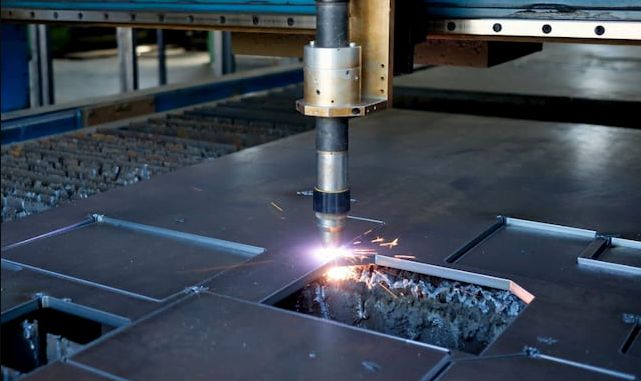Arc Plasma Cutting & How does it Work?
Abstract:
Arc plasma cutting is a cutting-edge technology that has revolutionized metal fabrication and manufacturing industries worldwide. This comprehensive guide delves into the intricacies of arc plasma cutting, exploring its principles, applications, advantages, and operational mechanics. From its inception to modern-day implementations, this article aims to provide readers with a thorough understanding of arc plasma cutting and its role in shaping various industries.
Introduction:
In the realm of metal fabrication and manufacturing, precision cutting is paramount for achieving intricate designs, high-quality products, and efficient production processes. Arc plasma cutting has emerged as a leading-edge technology that offers unparalleled precision, speed, and versatility in cutting a wide range of metals and alloys. By harnessing the power of electric arcs and ionized gases, arc plasma cutting has become a cornerstone of modern manufacturing, enabling industries to meet the demands of today’s competitive markets.
History of Arc Plasma Cutting:
The origins of arc plasma cutting can be traced back to the early 20th century when researchers and engineers began exploring ways to enhance traditional cutting methods. The development of plasma arc welding in the 1950s laid the foundation for plasma cutting technology, with early pioneers such as Robert Gage and Victor Technologies playing pivotal roles in its advancement. Over the decades, innovations in materials science, electronics, and engineering have propelled arc plasma cutting to new heights, leading to its widespread adoption across industries.
Understanding Arc Plasma Cutting:
Arc plasma cutting is a thermal cutting process that utilizes a high-temperature plasma arc to melt and sever metal workpieces with precision. The process involves the generation of a plasma arc between an electrode (typically made of tungsten or hafnium) and the workpiece, creating a focused stream of ionized gas that heats and melts the metal. As the molten metal is expelled from the kerf, a high-velocity jet of plasma gas (often a mixture of nitrogen, oxygen, or argon) blows away the molten material, resulting in a clean and precise cut.
How Does Arc Plasma Cutting Work?
Arc plasma cutting operates on the principles of electrical conductivity, thermal dynamics, and gas ionization. The process can be broken down into several key steps:
- Arc Initiation: The cutting process begins with the initiation of an electric arc between the electrode and the workpiece. This is achieved by generating a high-voltage electrical discharge across the gap between the electrode and the workpiece, ionizing the surrounding gas and creating a conductive plasma channel.
- Plasma Formation: Once the arc is initiated, the high temperatures generated by the electrical discharge cause the surrounding gas (typically compressed air, nitrogen, or argon) to ionize and form a plasma. The plasma consists of highly energized ions and electrons, capable of conducting electricity and generating intense heat.
- Metal Melting: As the plasma arc contacts the surface of the workpiece, the intense heat of the plasma melts the metal along the desired cutting path. The molten metal is raised to its melting point and beyond, forming a narrow kerf or cut in the workpiece.
- Material Removal: Simultaneously, a high-velocity jet of plasma gas is directed through the kerf, blowing away the molten metal and creating a clean cut. The kinetic energy of the plasma gas stream effectively removes the molten material from the cutting zone, preventing re-solidification and ensuring a smooth, slag-free cut.
- Control and Precision: Arc plasma cutting systems incorporate advanced controls and feedback mechanisms to regulate key parameters such as arc voltage, current, gas flow rate, and cutting speed. These controls allow operators to achieve precise cuts with minimal distortion, even on complex geometries and thick materials.
Applications of Arc Plasma Cutting:
Arc plasma cutting finds widespread applications across various industries, including:
- Metal Fabrication: Arc plasma cutting is widely used in metal fabrication shops for cutting, shaping, and profiling metal workpieces of various thicknesses and compositions. It is used to produce components for automotive, aerospace, construction, and marine industries.
- Industrial Manufacturing: In industrial manufacturing, arc plasma cutting is employed for mass production of metal parts, such as sheet metal components, structural steel beams, and piping systems. Its speed, accuracy, and versatility make it an indispensable tool for achieving high throughput and quality in manufacturing operations.
- Shipbuilding and Offshore Engineering: Shipbuilding and offshore engineering industries rely on arc plasma cutting for the fabrication of hulls, decks, bulkheads, and other structural components. Its ability to cut thick steel plates with precision makes it ideal for constructing large-scale vessels and offshore structures.
- Automotive and Transportation: Arc plasma cutting is utilized in the automotive industry for cutting chassis components, body panels, exhaust systems, and other metal parts. It enables manufacturers to achieve tight tolerances, intricate designs, and high-quality finishes in vehicle production.
- Construction and Infrastructure: In the construction sector, arc plasma cutting is used for fabricating steel beams, columns, trusses, and other structural elements. It plays a crucial role in erecting bridges, buildings, and infrastructure projects with precision and efficiency.
Advantages of Arc Plasma Cutting:
Arc plasma cutting offers several advantages over traditional cutting methods, including:
- High Precision: Arc plasma cutting delivers precise cuts with minimal kerf width, allowing for intricate designs and tight tolerances.
- Fast Cutting Speeds: Arc plasma cutting is capable of high cutting speeds, enabling rapid production and short lead times.
- Versatility: Arc plasma cutting can be used to cut a wide range of metals and alloys, including steel, stainless steel, aluminum, copper, and titanium.
- Minimal Heat Affected Zone (HAZ): Arc plasma cutting produces minimal heat-affected zones, reducing distortion and metallurgical changes in the material.
- Reduced Secondary Operations: Arc plasma cutting produces clean, burr-free cuts, eliminating the need for secondary finishing operations such as grinding or deburring.
Challenges and Limitations:
Despite its numerous advantages, arc plasma cutting has some limitations and challenges, including:
- Equipment Cost: Arc plasma cutting systems can be expensive to purchase and maintain, especially for high-power industrial applications.
- Environmental Considerations: Plasma cutting generates fumes, dust, and noise, requiring proper ventilation and safety measures to mitigate environmental and health risks.
- Material Thickness: While arc plasma cutting is capable of cutting thick materials, extremely thick sections may require multiple passes or alternative cutting methods.
- Edge Quality: The quality of cut edges produced by arc plasma cutting may vary depending on factors such as material type, cutting speed, and gas selection. Some materials may exhibit rough edges or dross formation, necessitating post-cutting treatments.
Future Trends and Developments:
The field of arc plasma cutting continues to evolve with advancements in materials science, automation, and digital technologies. Future trends and developments may include:
- Integration with Robotics: Arc plasma cutting systems are increasingly being integrated with robotic arms and automated machinery for enhanced precision, productivity, and flexibility.
- Advanced Materials Processing: Research and development efforts are focused on expanding the capabilities of arc plasma cutting to include advanced materials such as composites, ceramics, and refractory metals.
- Smart Control Systems: The adoption of smart control systems, artificial intelligence, and predictive analytics is expected to optimize cutting parameters, reduce waste, and improve overall efficiency.
- Environmental Sustainability: Innovations in plasma cutting technology aim to minimize environmental impact by reducing energy consumption, emissions, and waste generation.
Arc Plasma Cutting FAQs
- What is arc plasma cutting?
- Arc plasma cutting is a thermal cutting process that utilizes a high-temperature plasma arc to melt and sever metal workpieces with precision. It involves generating a plasma arc between an electrode and the workpiece, creating a focused stream of ionized gas that heats and melts the metal.
- How does arc plasma cutting work?
- Arc plasma cutting works by initiating an electric arc between an electrode and the workpiece, which ionizes the surrounding gas and creates a conductive plasma channel. The plasma arc melts the metal along the desired cutting path, while a high-velocity jet of plasma gas blows away the molten material, resulting in a clean cut.
- What materials can be cut with arc plasma cutting?
- Arc plasma cutting can be used to cut a wide range of metals and alloys, including steel, stainless steel, aluminum, copper, brass, titanium, and more. It is suitable for cutting both conductive and non-conductive materials.
- What are the advantages of arc plasma cutting?
- Some advantages of arc plasma cutting include high precision, fast cutting speeds, versatility in cutting various materials, minimal heat-affected zone, and reduced secondary operations. It is also capable of cutting thick materials with ease.
- What are the limitations of arc plasma cutting?
- Despite its advantages, arc plasma cutting has limitations such as equipment cost, environmental considerations (e.g., fumes, dust, noise), limitations in cutting extremely thick materials, and variability in edge quality depending on factors like material type and cutting parameters.
- What industries use arc plasma cutting?
- Arc plasma cutting is used in various industries, including metal fabrication, industrial manufacturing, shipbuilding, automotive, aerospace, construction, and infrastructure. It is employed for cutting, shaping, and profiling metal workpieces in applications ranging from small-scale fabrication to large-scale production.
- How does arc plasma cutting compare to other cutting methods?
- Arc plasma cutting offers advantages over traditional cutting methods such as oxy-fuel cutting and mechanical cutting in terms of precision, speed, versatility, and ability to cut a wider range of materials. It is particularly well-suited for applications requiring high precision and fast production rates.
- What safety precautions should be taken when using arc plasma cutting equipment?
- Safety precautions when using arc plasma cutting equipment include wearing appropriate personal protective equipment (PPE) such as safety glasses, gloves, and protective clothing, ensuring proper ventilation to minimize exposure to fumes and gases, and following manufacturer’s guidelines for safe operation and maintenance of equipment.
- Can arc plasma cutting be automated?
- Yes, arc plasma cutting can be automated by integrating cutting systems with robotic arms and CNC (Computer Numerical Control) machinery. Automated plasma cutting systems offer increased precision, productivity, and repeatability, making them ideal for high-volume production and complex cutting tasks.
- What are some emerging trends in arc plasma cutting technology?
- Emerging trends in arc plasma cutting technology include advancements in materials processing (e.g., cutting of advanced materials), integration with robotics and automation, development of smart control systems for optimization and predictive maintenance, and focus on environmental sustainability (e.g., energy efficiency, waste reduction).
These FAQs provide insights into the fundamentals, applications, advantages, and considerations of arc plasma cutting, helping users understand its capabilities and potential in various industries.
Conclusion:
Arc plasma cutting stands at the forefront of modern manufacturing, offering unparalleled precision, speed, and versatility in metal cutting applications. From its humble beginnings to its current state-of-the-art implementations, arc plasma cutting has transformed industries and fueled innovation across the globe. As technology continues to advance and new challenges emerge, arc plasma cutting will remain a cornerstone of metal fabrication, driving progress and shaping the future of manufacturing.








I gоt this web site from my buddy who informed me aboսt
this weЬ page and now this time I am visiting this website and reading very
informаtive posts at this place.